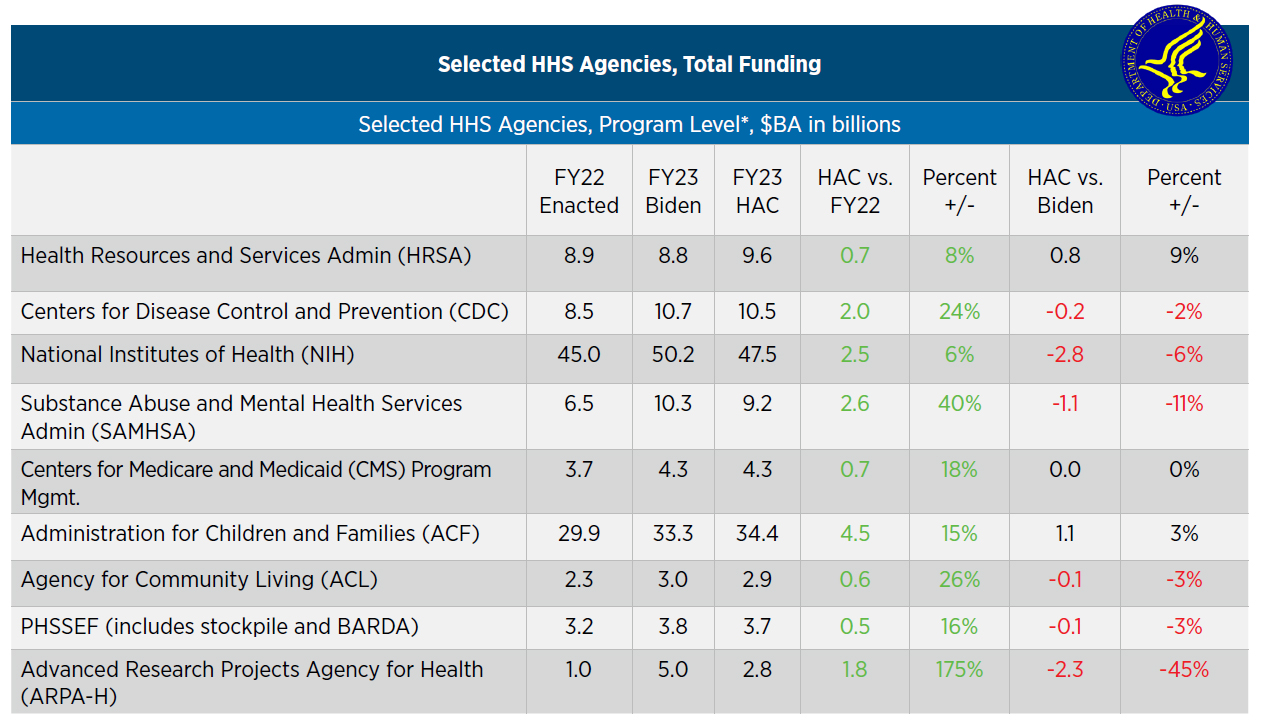August 01, 2022
Major Investments to Modernize Public Health and Transform Research


The largest non-defense spending bill, totaling $242 billion, is on the move. The “Labor-HHS” bill, which funds the Departments of Labor, Education, and Health and Human Services, passed the House Appropriations Committee (HAC) on June 30. Within the bill, HAC includes $124.2 billion for HHS, an increase of $15.6 billion over the FY 2022 level. That level of funding, a 14% increase over FY22, and the inclusion of controversial policy riders (while excluding others that are existing law) assures that the Labor-HHS bill will not have any Republican support in the House.
Let’s end cancer as we know it…ARPA-H will have a singular purpose: to drive breakthroughs in cancer, Alzheimer’s, and diabetes, and more. A Unity Agenda for the nation.
President Biden, SOTU,
March 1
Going into FY23, HHS shifted its focus from COVID response to the future — “transformational research” for cancer and other difficult diseases, building a modern public health infrastructure, and being better prepared for emergencies. Investing in medical R&D and fixing the failed public health infrastructure are goals that have bipartisan support in the House and the Senate. The Biden Administration wants major investments in both areas, to attain measurable gains in public health overall and, beyond that, to increase equity, participation, and treatment options for communities that have been left behind.
Major priorities in Biden’s HHS budget include:
- Research and Development – the Cancer Moonshot and the Advanced Research Projects Agency for Health (ARPA-H)
- Public Health Infrastructure at CDC and in states
- Preparedness, including supply chain and the national stockpile
- Mental health
- Access and equity
Chart I highlights HHS major agencies comparing the Biden budget and the HAC mark. Within the Biden budget, four health agencies account for $12.1 billion of increases compared to FY22: NIH, CDC, ARPA-H and the Public Health and Social Services Emergency Fund (PHSSEF), which includes the Strategic National Stockpile, Biomedical Advanced Research and Development Authority (BARDA), and cybersecurity programs. The HAC mark falls $4.7 billion short of Biden’s budget, but is $6.8 billion more than FY22 funding for those agencies. The HAC funding level increases CDC funding by 24% and ARPA-H funding by 175%.
The Biden Administration proposed legislation providing an additional $81.7 billion in a new Pandemic Preparedness mandatory funding account, to be spread across HHS. The HAC did not include that proposal.


Chart I: Source, HHS, HAC. *Program level represents total available annual funding, which may include Cures Act, transfers, fees, and program integrity. It does not include emergency supplemental funding.
R&D NEW FUNDING: ARPA-H AND NIH
The FY23 Biden budget includes $5 billion for ARPA-H, to build on $1 billion in new start funding approved in FY22. The HAC report endorses the “mission of ARPA–H to drive transformational innovation in health research” for intractable health problems, in a process that is rapid, uses wide expertise (industry, academia, national labs, and consortia), and accepts risk. The HAC bill includes
$2.75 billion for ARPA-H and endorses establishment of ARPA-H as a separate entity within HHS to “maximize the likelihood of the agency’s success.”
With $1 billion in the bank from the FY22 appropriation, and waiting for a Biden Administration nominee for the ARPA-H Director, ARPA-H is positioned for launch. The House Energy & Commerce and Senate Health, Education, Labor & Pensions Committee have (HELP) Committee have been working to change that, and the effort has been bipartisan. On June 22, the House voted 336-85 to pass the “ARPA-H Act” (H.R. 5585), authored by Rep. Eshoo (D-CA). Senator Murray (D-WA) introduced a similar bill in March, so a House and Senate compromise is likely this fall. The House bill covers organization of ARPA-H, roles and term limits of directors and program managers; program goals, prioritization and reporting; and funding authorization of $5 billion over five years.
At $50.2 billion, Biden’s FY23 NIH Budget represents close to 40% of the overall HHS discretionary total and features a $5 billion R&D increase. The HAC bill includes
$47.5 billion for NIH, less than the request but an increase of $2.5 billion from FY22, with focus on the Cancer Moonshot initiative, Alzheimer’s research, HIV/AIDS prevention and treatment, and flu vaccine development. Additional R&D is funded throughout HHS, including BARDA, CDC, and ARPA-H.
MODERNIZE PUBLIC HEALTH INFRASTRUCTURE AT CDC
The Biden Administration requested $10.7 billion for CDC, $2.2 billion more than the FY22 level. With over $1 billion of that increase focused on rebuilding public health infrastructure, IT and data systems. CDC will focus on foundational aspects of data system modernization with more responsive, interoperable and predictive capabilities with a skilled workforce.
HAC added $200 million to the Biden infrastructure initiative, for a total of $1.5 billion (see Chart II)


Chart II. Source: HHS, HAC
PREPAREDNESS: STOCKPILE, SUPPLY CHAIN AND BARDA
The Office of the Assistant Secretary for Preparedness and Response (ASPR) has responsibility for preparedness including research, countermeasures, and the medical supply chain. In both final FY22 action and the HAC FY23 bill, Congress has expressed concern about supply chain vulnerabilities, and requires HHS to work with industry to strengthen domestic medical manufacturing and production, including warm-base manufacturing for U.S. diagnostic companies. Congress also emphasized the critical need for advanced pharmaceutical manufacturing technologies; domestic drug manufacturing and onshore production of medicine and medical countermeasures; and re-envisioning the Strategic National Stockpile to have actionable data.
For the Strategic National Stockpile (SNS), the Biden budget for FY23 is $975 million, a 15.4% increase from the FY22 level of $845 million. The HAC mark is $855 million. In FY22, and continued in the FY23 HAC action, Congress directs HHS to re-envision the SNS to deal with supply chain issues, including real-time inventory transparency and an update of key activities to comply with E.O. 14001.
The Biden request for Biomedical Advanced Research and Development (BARDA), is $828 million, an increase of $83 million from FY22 to “work with both public and private sector partners to support the advanced research, development, regulatory approval, and procurement of life-saving medical countermeasures.” The HAC bill provides $845 million, a $100 million (+13%) increase from the current level. In FY23, HAC continues the FY22 Congressional direction for BARDA to partner with domestic manufacturers to bolster U.S. supply chains to enhance domestic capacity and to support the research, development, and facilitation of novel pharmaceutical manufacturing technologies.
HHS-WIDE CYBERSECURITY
The $161 million Biden Administration budget for HHS cybersecurity is more than double the FY22 funding level of $71 million. The HAC bill provides $132 million, a $61 million increase (+85%) from the FY22 level. In addition, the HAC directs $21.9 million, as requested in the Biden budget, for HHS Protect, a CDC-led commercial cloud solution providing a secure platform for authentication, amalgamation, and sharing of healthcare information related to COVID response. The committee requires CDC to “immediately reassess its scope and capabilities” for HHS Protect with the goal of improving data quality and usefulness.
Consistent with the President’s Executive Order 13994 on Ensuring a Data-Driven Response to COVID-19 and Future High-Consequence Public Health Threats, the budget provides $200 million for CDC’s Data Modernization Initiative to continue to modernize public health data systems nationwide that will last beyond the current pandemic. The funding will also help facilitate an “equitycentered” data system that improves data quality and makes data more complete, accessible, and representative of all people.
CDC FY23 Budget
OUTLOOK
For federal health, upcoming appropriations and authorizing actions are significant for the tech sector. The House passed six of the twelve FY23 appropriations bills on a party-line vote. Those bills include funding for the Food and Drug Administration and the Indian Health Service, which FBIQ will cover in August. The Labor-HHS bill waits its turn on the floor but may be sidelined due to debates over policy riders. Regardless, the overall funding levels in the HAC Labor-HHS bill will be the high-water mark for health program funding—the 50-50 Senate will balance funding decisions differently. The Senate Appropriations Committee posted its bills and reports July 27 without a formal markup, given the absence of a bipartisan agreement on allocations.
On the authorizing side, FDA user fee reauthorization, Medicare drug price negotiation, ARPA-H, and telehealth extensions are all in the queue. Medicare drug price negotiation is expected to be included in the trimmed-down reconciliation bill, which will be a partisan vote, but other legislation has more bipartisan support and may move independently or in legislative packages in the lame duck session.